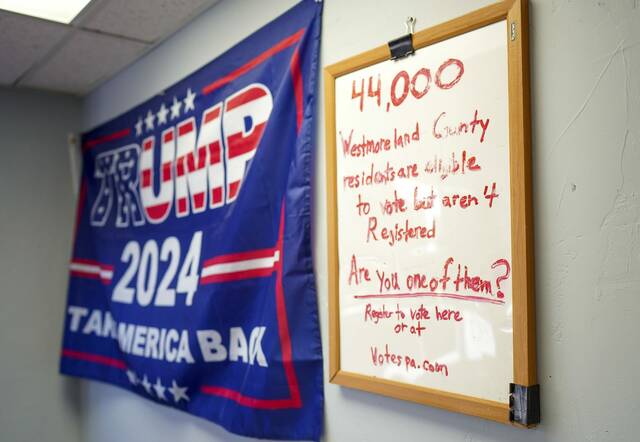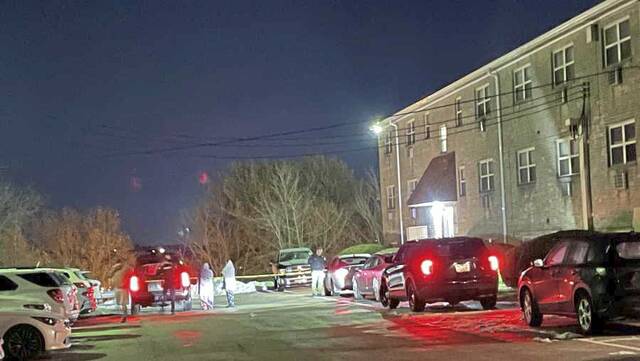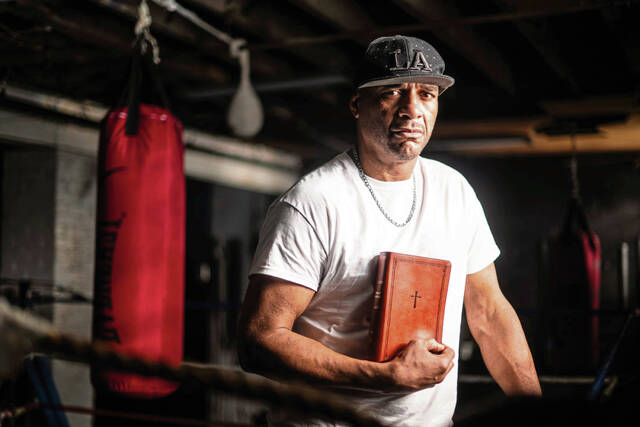Bill Bretz had few options to further his political interests while a senior majoring in political science at Saint Vincent College.
It was 1993. He was a Republican.
“My professor told me that if I wanted to do anything in politics, I would have to change my party registration,” said Bretz, now 53, of Hempfield. “I remember telling him that I don’t want to do that.”
In 2024, Westmoreland County is no longer dominated by Democrats.
Bretz, who since 2020 has been chairman of the Westmoreland County Republican Committee, has presided over a surge to power for the party that just a generation ago was noncompetitive in Westmoreland County. That same professor might very well today tell a student interested in politics to register as a Republican to have any hope of success in the county.
Democrats in the early 1990s held a nearly 3-to-1 edge in voter registration and held almost every elected office in the county. Republicans struggled to field candidates, as the county was an afterthought in state and federal elections.
Over the course of the next three decades, the tables have turned. Republicans now hold a significant edge in voter registration and occupy nearly every county elected office outside of one seat mandated by law to the minority party. The GOP has control over dozens of local municipal governments.
It’s a power play that emerged because of socio-economic changes and a media onslaught that changed political attitudes in the county’s industrial towns and rural areas, according to political observers.
Republicans this November account for nearly 52% of the county’s 255,775 registered voters and outnumber Democrats by 40,000.
“Westmoreland County is a really good example of changes, a de-alignment and a re-alignment,” said Paul Adams, an associate political science professor at the University of Pittsburgh at Greensburg. “Here in Westmoreland County, it’s a combination of population declines and that the population is older and more socially conservative. It’s an area where the economy has been left behind, as jobs moved south and abroad.”
Party swings
From the Civil War until the 1930s, the county was a Republican stronghold that surged to the left during Franklin Delano Roosevelt’s New Deal era.
The beginning of the current political shift started to emerge in the 1980s, Adams said, during the presidency of Ronald Reagan but didn’t begin to take hold until more than a decade later. That’s when a majority of voters shifted away from the middle.
Media changed the game, too, as conservative advocates such as Rush Limbaugh and Fox News became bully pulpits for the GOP.
State Sen. Kim Ward, R-Hempfield, came onto Westmoreland County’s political scene volunteering for the fledgling campaign of Republican Rick Santorum during his successful campaign for U.S. Senate in the early 1990s. In 1994, Ward was elected as the local GOP chairwoman at a time when Republicans were at their lowest point in local politics. The party had about 50,000 registered voters.
Grassroots campaigning paved the way for early successes that weren’t seen at the ballot box in high-profile races, Ward said.
“We only had about $50,000 to spend, and we used that money to win local elections: supervisors, councils and local school boards. We worked hard, and Mr. Scaife was a big help to us,” Ward said.
Richard Mellon Scaife, the former publisher of the Tribune-Review, used the editorial pages of Westmoreland County’s largest newspaper to support GOP issues and helped finance efforts to strengthen the party’s reach, Ward said.
Those efforts led to steady rises in voter registration, although major electoral wins were still years away.
Nonetheless, Democrats saw their once-dominant hold on local politics begin to ease.
“We had young people leave, and the newspaper was influencing voters,” said former Commissioner Tom Balya, a Democrat. “Our party struggled to attract new voters. Maybe a part of it was overconfidence, and there were factional issues among us Democrats that didn’t help our strength.”
Balya was elected county commissioner in 1995 and served 16 years on the board that had been controlled by Democrats since the 1950s. Balya retired at the end of 2011, after which Republicans took over a majority on the board.
The county’s economic identity contributed to the political shift, which was further solidified as Republicans started to win seats in county and state elections, Balya said. Unions became less influential in local politics, and generational party identity was fading away, he said.
“We used to have a lot of people who stayed in the Democratic Party because their family and local municipal leaders were Democrats,” Balya said.
Registration numbers improved for Republicans throughout the 2000s. In 2019, the GOP took over as the county’s dominant political party.
Strength today
Republicans now hold control over the courthouse and occupy all state House and Senate seats from Westmoreland County. Republican presidential candidates have won Westmoreland County every year since 1996, and the county has become a reliable support base for the GOP.
Bretz said he expects the momentum to continue. The party added about 5,600 new members to its ranks over the last six weeks, with more expected into 2025.
“We have to continue winning over the public’s minds, and it’s a job to maintain that,” he said. “We think there is still a large number of registered voters out there who aren’t yet Republicans.”
Democrats certainly know where they stand.
The party’s headquarters during its heyday occupied prominent real estate in downtown Greensburg. It now rents office space just outside the city limits where there is added security to guard against threats of political violence.
Committee Chairwoman Michelle McFall said she sees a path forward for local Democrats and that growth is coming. She also conceded that process could take years.
Even with its minority status, Westmoreland County still has the second-largest concentration of Democratic voters in Western Pennsylvania with more than 91,000.
“Westmoreland County’s political landscape is a pendulum, and at some point the pendulum has to swing back,” McFall said. “I don’t think it will go any further, and it’s going to start coming back on it’s own.
“It’s the nature of the human condition. This county isn’t a Republican stronghold. It’s a MAGA stronghold. It’s going to be a slow (Democratic) build, and we will see it happen incrementally. Changing minds takes time.”













